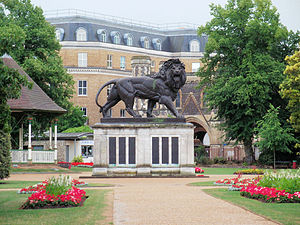- Maiwand Lion
-
Maiwand Lion 
Artist George Blackall Simonds Year 1886 Type Sculpture 51°27′25″N 0°58′03″W / 51.456952°N 0.967481°WCoordinates: 51°27′25″N 0°58′03″W / 51.456952°N 0.967481°W The Maiwand Lion is a sculpture and war memorial in the Forbury Gardens, a public park in the town of Reading, in the English county of Berkshire. The statue was named after the Battle of Maiwand and was erected in 1886 to commemorate the deaths of 329 men from the 66th Berkshire Regiment during the campaign in Afghanistan between 1878 and 1880. It is sometimes known locally as the Forbury Lion.
The inscription on the plinth reads as follows:
This monument records the names and commemorates the valour and devotion of XI (11) officers and CCCXVIII (318) non-commissioned officers and men of the LXVI (66th) Berkshire Regiment who gave their lives for their country at Girishk Maiwand and Kandahar and during the Afghan Campaign MDCCCLXXIX (1879) - MDCCCLXXX (1880).
"History does not afford any grander or finer instance of gallantry and devotion to Queen and country than that displayed by the LXVI Regiment at the Battle of Maiwand on the XXVII (27th) July MDCCCLXXX (1880)."
Despatch of General Primrose.The regiment lost approximately 258 men out of 500 (reports of the number vary) at the battle of Maiwand, having faced an Afghan army ten times larger than the British contingent. Eleven of the men, protecting the colours, made such a brave stand before their deaths that the Afghans who fought them reported it with great respect. Sir Arthur Conan Doyle based his character Doctor Watson on the regiment's Medical officer, Surgeon Major A F Preston who was injured in battle.[1][2]
The sculptor was George Blackall Simonds, a member of a Reading brewing family from Simonds' Brewery. The sculpture took two years to design and complete, and the lion is one of the world's largest cast iron statues. Rumours persist that Simonds committed suicide on learning that the lion's gait was incorrectly that of a domestic cat. In fact, he made careful observations on lions and the stance was anatomically correct despite various African ex-pats disagreeing. He also lived for another 43 years, enjoying continuing success as a sculptor going on to create a statue of Queen Victoria (1887) and a statue of George Palmer (1891). He retired from sculpting in 1903 and worked in the family business eventually becoming its chairman in 1910. In 1922 he temporarily came out of retirement to build the Bradfield war memorial which commemorated the deaths in the First World War of those in the 2nd Battalion, South Wales Borderers which included his son.[3]
The Maiwand Lion features on the front page of one of the local newspapers, the Reading Post, and also on the Reading Football Club crest.
The statue is made of cast iron, weighing 16 tons, cast by H. Young & Co. of Pimlico in 1886. It is supported on a terracotta pedestal. The rectangular pilastered plinth carries tablets recording the names of the dead, together with inscription above. The whole is listed grade II by English Heritage.[4]
The Loddon Brewery, located in Dunsden Green close to Reading, brew an IPA called Forbury Lion.[5]
References
- ^ "Maiwand Lion – Forbury Gardens, Reading". Reading Museums. Archived from the original on 2007-09-28. http://web.archive.org/web/20070928000734/http://www.readingmuseum.org.uk/collections/album/pdfs/maiwand-25.pdf. Retrieved 2007-11-26.
- ^ "The story of the Infantry of Berkshire and Wiltshire (to 1881)". The Rifles (Berkshire and Wiltshire) Museum. https://www.thewardrobe.org.uk/historyto1881.php. Retrieved 2007-11-26.
- ^ "Reading's Great People - George Blackall-Simonds". Reading Borough Libraries. http://www.readinglibraries.org.uk/services/local/simonds.htm. Retrieved 2007-11-26.
- ^ "Images of England - Maiwand Memorial". English Heritage. http://www.imagesofengland.org.uk/Details/Default.aspx?id=38938&mode=quick. Retrieved 2007-11-26.
- ^ "Seasonal Loddon Brewery Beers". Loddon Brewery. http://www.loddonbrewery.com/beers/seasonal.html. Retrieved 2007-11-26.
Bibliography
- Stacpoole-Ryding, Richard J., Maiwand: The Last Stand of the 66th (Berkshire) Regiment in Afghanistan, 1880; The History Press; Stroud, Gloucestershire, 2008.
Grade I Grade II* Reading Abbey · Reading Town Hall · Royal Berkshire Hospital · St Mary's Church, Castle Street · St Peter's Church · Watlington HouseGrade II Abbey Mill, Reading · All Saints' Church · Bath Road Reservoir · Battle Library · Broad Street Independent Chapel · Brock Barracks · Caversham Park · Coley Park · The Forbury Hotel · Foxhill House · High Bridge · Highdown School · Kendrick School · King's Meadow swimming pool · Leighton Park School · Maiwand Lion · Malmaison Hotel · New Town Primary School · Prospect Park · Queen Anne's School · Reading Old Cemetery · Reading railway station · Reading School · St Giles' Church · St James's Church · Reading Town Hall · Vachel Almshouses · Wantage HallCategories:- British military memorials and cemeteries
- Buildings and structures in Reading, Berkshire
- Culture in Reading, Berkshire
- Colossal statues
- Grade II listed buildings in Reading
- Monuments and memorials in England
- Outdoor sculptures in England
- Lions in art
Wikimedia Foundation. 2010.


